اثر مبادل های گرمایی در طراحی مبدل زمین هوا The impact of latent heat exchanges on the design of earth air heat exchangers
- نوع فایل : کتاب
- زبان : انگلیسی
- ناشر : Elsevier
- چاپ و سال / کشور: 2018
توضیحات
رشته های مرتبط مهندسی مکانیک
گرایش های مرتبط تبدیل انرژی و مکانیک سیالات
مجله مهندسی حرارتی کاربردی – Applied Thermal Engineering
دانشگاه Mechanical Engineering Graduate Program – Rio Grande do Sul – Brazil
منتشر شده در نشریه الزویر
کلمات کلیدی مبدل حرارتی زیرزمینی، آب و هوای گرمسیری، طراحی
گرایش های مرتبط تبدیل انرژی و مکانیک سیالات
مجله مهندسی حرارتی کاربردی – Applied Thermal Engineering
دانشگاه Mechanical Engineering Graduate Program – Rio Grande do Sul – Brazil
منتشر شده در نشریه الزویر
کلمات کلیدی مبدل حرارتی زیرزمینی، آب و هوای گرمسیری، طراحی
Description
1. Introduction and background An earth-air heat exchanger (EAHE) consists of one or several ducts buried in the ground, connected from one end to the outdoor air, and to the other end to the ventilation system of a building. Because of the high thermal inertia of the soil, the outdoor temperature variations are progressively smoothed along with the soil depth. Therefore, the ground can be considered as a huge thermal reservoir, which temperature remains milder and more stable than the outdoor air temperature all over the year. The air temperature at the pipe outlet is different from the inlet thanks to the heat exchanges occurring with the soil. This potentially allows reducing the heating or cooling loads at building scale. Most cases are related to office buildings or typical residential buildings. A considerable number of papers focused on greenhouses [1–6], yet heat and mass loads differ strongly from buildings. At the design stage, the impact of the pipes length, the number of pipes, the cross section of the pipe and the pipe depth have to be determined in order to enhance the EAHE performances. The latter is of significance. Most authors advise burying the pipes as deeply as possible in order to take advantage on the ground thermal inertia. The excavation cost is the sole feature limiting the pipe depth, which generally remains between 1 and 3 meters. As observed in [7], a deeply buried pipe should indeed be effective at smoothing yearly temperature variations. However, it may be worth smoothing daily variations instead, depending on the building loads and on the local climate. This could be easily achieved by burying pipes less deeply. Many authors rely on heat transfer calculations to give a comprehensive analysis of the thermal behavior of EAHE and to improve its design. The methodology differs in terms of complexity and computational time. For example, the transient heat transfer taking place in the pipe was solved analytically in [8] under strong assumptions such as undisturbed soil surface temperature. Such an approach allows to integrate easily the EAHE model in a building simulation tool, as exemplified in [9,10]. Heat transfer in the ground was modelled to obtain more realistic results, as in [4,11-13]. A more refined approach was presented in [11], where a Computational Fluid Dynamic code was used to model the air transfer in the pipes whereas heat transfer in the ground was modelled up to a depth of 15m. However because of the high computational time, some simplifications were needed, like by considering a smaller domain for heat transfer in the soil. A possible alternative is to use model reduction techniques as presented in [14] in the case of borehole heat exchangers. The drawback of these techniques is that they are time-consuming and should not be employed for feasibility studies.


